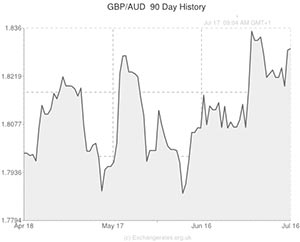
Following the release of the UK’s employment figures on Wednesday, the Pound to Australian Dollar (GBP/AUD) exchange rate continued trending in a stronger position.
The pairing had advanced on Tuesday in response to the UK’s upbeat Consumer Price Index and managed to hold on to these gains as the week progressed.
Although lacklustre UK wage growth remains a cause of concern, the UK’s headline unemployment rate slid to an over five-year low and the percentage of employed persons reached its highest level on record in the three months through May.
In fact, the report prompted this encouraging response from UK Prime Minister David Cameron; ‘Today’s figures show more people have the security of a job than ever before. Full employment is a key aim of our long-term economic plan.’
After the employment figures were published the Pound was trending at multi-month highs against commodity currencies like the ‘Aussie’, New Zealand Dollar and ‘Loonie’.
While this week’s Chinese growth figures surpassed expectations, a factor which would ordinarily bolster the Australian Dollar, the asset has come under pressure from a dovish Reserve Bank of Australia and mounting bets that a US interest rate increase could be approaching.
During her semi-annual testimony to the Senate Committee, Federal Reserve Chairwoman Janet Yellen hinted that if US inflation and employment continues to improve, interest rates could be raised sooner than currently expected.
This remark took a toll on higher-yielding assets like the Australian Dollar, as did renewed tensions in Ukraine.
However, overnight the AUD/USD pairing staged a modest rebound. The Pound to Australian Dollar exchange rate also shed around 0.2%.
During Australasian trading, the National Australia Bank (NAB) published its Business Confidence Index for the second quarter. The gauge edged down from 7 in the first quarter to 6 in the second, but the drop wasn’t as bad as some investors had feared given the severity of the National Budget.
The report showed that the strength of the Australian Dollar was having a mixed impact on the domestic economy. Although exporters have lamented the high ‘Aussie’, falling purchase costs have been a boon for wholesalers/retailers.
Alan Oster, NAB’s chief economist, issued the following statement with the figure; ‘With business activity seemingly on the rise, business may be able to maintain confidence at these levels for longer. However, an immediate risk stems from the recent collapse in consumer confidence and the rise in consumer anxiety that followed the Government’s ‘touch budget’. If this flows into consumer spending behaviour – tentative signs of which have already become evident – than it would only be a matter of time before firms react with a similarly negative response.’
Meanwhile, Australia’s Conference Board Leading Index came in at 0.2% in May, reversing the -0.2% decline recorded in April.
As economic reports for both the UK and Australia are thin on the ground before the weekend, any currency news for the Pound to Australian Dollar (GBP/AUD) exchange rate is likely to be occasioned by US developments – specifically the nation’s Initial Jobless Claims figures and the University of Michigan Confidence Index.
Australian Dollar (AUD) Exchange Rates
[table width=”100%” colwidth=”50|50|50|50|50″ colalign=”left|left|left|left|left”]
Currency, ,Currency,Rate ,
Australian Dollar, ,US Dollar, 0.9365,
,US Dollar, 0.9365,
Australian Dollar, ,Euro, 0.6921,
,Euro, 0.6921,
Australian Dollar, ,Pound, 0.5471,
,Pound, 0.5471,
Australian Dollar, ,New Zealand Dollar, 1.0766,
,New Zealand Dollar, 1.0766,
US Dollar, ,Australian Dollar, 1.0675,
,Australian Dollar, 1.0675,
Euro, ,Australian Dollar, 1.4437,
,Australian Dollar, 1.4437,
Pound Sterling, ,Australian Dollar, 1.8268,
,Australian Dollar, 1.8268,
New Zealand Dollar, ,Australian Dollar, 0.9276,
,Australian Dollar, 0.9276,
[/table]

Comments are closed.